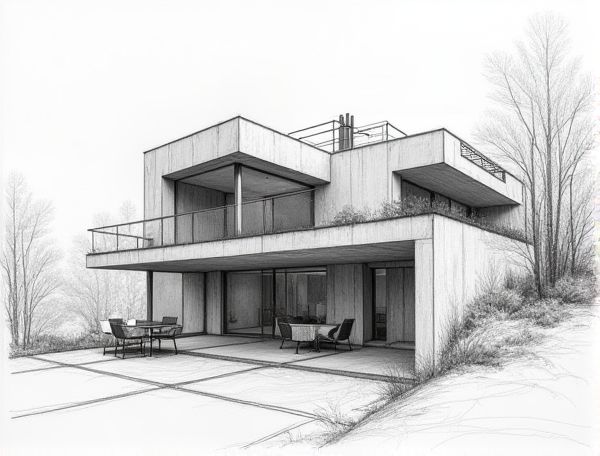
Photo illustration: High-tech home design with automated bioclimatic facades
High-tech home design integrates automated bioclimatic facades that adapt to environmental conditions, optimizing energy efficiency and enhancing indoor comfort seamlessly. Discover how these innovative systems can transform your living space by reading more in the article.
Introduction to High-Tech Home Design
High-tech home design integrates cutting-edge technology and innovative materials to create smart, efficient living spaces tailored to your lifestyle. Advanced automation systems, energy-efficient solutions, and sleek, modern aesthetics redefine comfort and functionality in residential architecture. Embracing these elements enhances convenience, security, and sustainability in your home environment.
Understanding Automated Bioclimatic Facades
Automated bioclimatic facades optimize your home's energy efficiency by adapting to environmental conditions such as sunlight, temperature, and wind, using sensors and responsive materials. This smart technology regulates indoor climate naturally, reducing reliance on HVAC systems while enhancing comfort and sustainability.
Key Features of Bioclimatic Facade Systems
Bioclimatic facade systems enhance home energy efficiency by integrating natural ventilation, solar shading, and thermal insulation to regulate indoor temperatures. These facades utilize smart materials and adaptive elements that respond to environmental changes, reducing reliance on artificial heating and cooling. Incorporating daylight optimization and moisture control further improves occupant comfort while minimizing energy consumption.
Smart Materials and Cutting-Edge Technologies
Smart materials like self-healing concrete and thermochromic windows revolutionize home design by enhancing durability and energy efficiency. Cutting-edge technologies including IoT-integrated systems and AI-driven climate control optimize comfort and resource management within living spaces. These innovations enable sustainable, adaptive, and intelligent homes that respond dynamically to environmental changes and occupant needs.
Energy Efficiency and Sustainability Benefits
Incorporating energy-efficient technologies and sustainable materials in home design significantly reduces utility costs and environmental impact by minimizing energy consumption and carbon emissions. Strategies such as advanced insulation, solar panels, and passive heating/cooling systems enhance indoor comfort while promoting long-term ecological responsibility.
Integration with Home Automation Systems
Seamless integration with home automation systems enhances your living experience by allowing centralized control over lighting, climate, security, and entertainment. Smart home design leverages IoT devices to optimize energy efficiency while providing personalized comfort and increased convenience throughout your space.
Design Flexibility and Aesthetic Appeal
Design flexibility in home architecture allows seamless integration of multifunctional spaces tailored to evolving lifestyle needs, enhancing overall functionality without compromising aesthetic appeal. Utilizing versatile materials and adaptable layouts maximizes space efficiency while creating visually harmonious environments that reflect personalized style preferences.
Enhancing Indoor Comfort and Well-being
Incorporating advanced insulation materials and smart HVAC systems significantly enhances indoor comfort by maintaining optimal temperature and air quality throughout the home. Integrating natural light, ergonomic furniture, and biophilic design elements promotes well-being by reducing stress and improving mood.
Case Studies: Innovative Bioclimatic Homes
Case studies of innovative bioclimatic homes highlight designs that maximize natural ventilation, solar gain, and thermal mass to reduce energy consumption significantly. These homes incorporate advanced materials and smart technology to adapt to local climate conditions, enhancing comfort and sustainability. Your next home can benefit from these insights by integrating passive design strategies that harmonize architecture with the environment.
Future Trends in High-Tech Residential Architecture
Future trends in high-tech residential architecture emphasize smart home automation, integrating IoT devices for enhanced energy efficiency and security. Sustainable materials like cross-laminated timber and self-healing concrete are increasingly incorporated to promote eco-friendly construction. Advanced 3D printing and modular building techniques accelerate construction timelines while allowing for customizable and adaptive living spaces.
 homedesy.com
homedesy.com